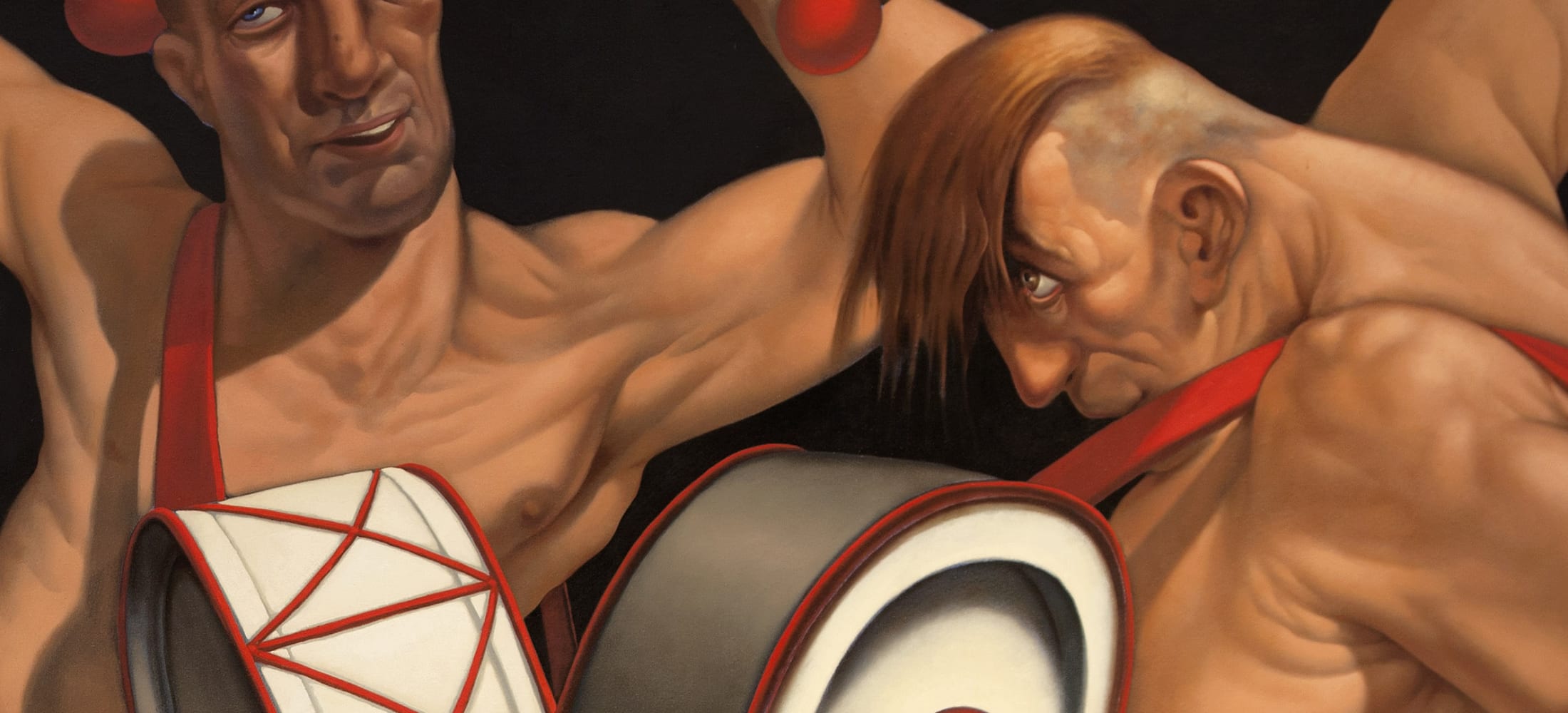
Peter Howson
Drum

Peter Howson
96 x 120 in

In 1995, the New Glasgow Boys, a group of Scottish artists including Steven Campbell, Ken Currie, Adrian Wisniewski and Howson were each commissioned to create one mural for the Glasgow Royal Concert Hall's main foyer. However, Howson was struck by a mural jinx. When the 12 x 8 foot canvas arrived at his studio, the artist assumed the mural would be painted horizontally. In fact, the murals were to be displayed in pairs vertically. Drum was painted horizontally, not vertically, depicting three men beating bass drums secured around their shoulders and necks. The band trio was inspired by the Glasgow Orange Walk, a controversial parade with participants of the Orange Order, an international Protestant fraternal order, as well as by other similar public displays throughout disparate Commonwealth nations during summer months.
Since the painting was made in the wrong format, the large-scale work was sold. A year later, in 1996, Howson unveiled the final missing mural of a large boxer called My Great Heart to be displayed alongside his artistic contemporaries. Lord Provost Pat Lally who unveiled the new mural stated, 'Any Peter Howson painting is worth waiting for. I'm sure the people of Glasgow will be delighted to see it has been completed.'
The three gigantic men in Drum are frozen, their hands are high in the air ready to beat their instruments. Their stance, alongside their dominating large feet highlights the muscular and sharp curves of the body. The envisioned scene of a marching band of thugs allowed Howson to explore both violent and dynamic imagery manifestation which is central to his signature style. From this point onwards drummers became firmly established as important recurring characters within Howson's major works. Whether shown stirring up crowds or jeering from the sidelines of his great mobs, drummers are key antagonists to Howson's many Noble Dossers.

Monoprints
Die Hard V and Die Hard II have corresponding content, both include three men hitting drums attached to their waist or slung across their shoulder. They hold two drumsticks with oversized red circular tips, actor and collector of Howson's work Steven Berkoff describes these drumsticks as 'enlarged matchsticks.' In the distant background behind the musicians are simplified outlines of tall buildings with square windows.
Although at first glance the monoprints appear homogenous, they were created employing two disparate print blocks since the position of the drummers' bodies are different. Howson has envisioned a fabricated scene of thug-like men drumming and dancing, as a subject matter to create an aggressive and animated scene. These prints provide an essential insight into the natural fundamentals of the artist's design and execution of his artistic practice.

About Peter Howson
Peter Howson is one of the UK's leading contemporary figurative painters. Born in London in 1958, at age four he moved with his family to Ayrshire. He studied at Glasgow School of Art from 1975-1977, returning in 1979 to complete a master's degree. He lives and works in Glasgow.
Emerging from Glasgow School of Art in the 1980s, Howson quickly proved his skill of capturing the maverick, the excessive, the non-conformist and his own personal understanding of the struggles of everyday life, with an ability to engage with individuals on the peripheries of society . He was a focal member of the group of young artists to emerge from the Glasgow School of Art during the 1980s dubbed the 'New Glasgow Boys'. In 1985, he was made the Artist in Residence at the University of St Andrews whilst working as a part-time tutor at Glasgow School of Art.
In 1992 he was commissioned by the Imperial War Museum to record the conflict in the former Yugoslavia. Howson was appointed official British war artist for Bosnia in 1993, where he witnessed the harrowing realities of war, culminating in a solo exhibition at the IWM London in 1994.
Howson is the recipient of numerous awards, including The Henry Moore Foundation Prize in 1998 and the Lord Provost's medal, Glasgow, in 1995. In 1996 he was made Doctor of Letters, Honoras Causa, by the University of Strathclyde. He was awarded an OBE in 2009. In 2011 Howson completed a dramatic rendering of the martyrdom of St John Ogilvie for the renovated St Andrew's Cathedral in Glasgow. The two year process of working on the commission was the subject of a BBC documentary.
Howson has exhibited throughout the UK and internationally, and in 2023 had a major retrospective at the Edinburgh City Art Centre. His works are represented in public collections including the Metropolitan Museum of Art and the Museum of Modern Art, New York; Tate, London; the Imperial War Museum, London; British Museum, London; National Galleries of Scotland, Edinburgh; Edinburgh City Art Centre; Glasgow Museums; the Victoria and Albert Museum, London; and National Gallery of Norway, Oslo.

